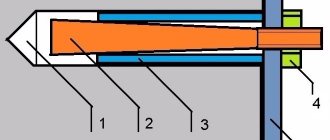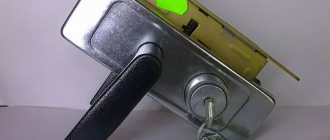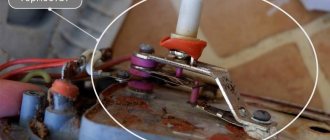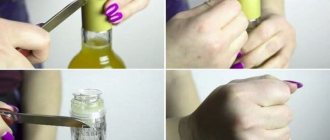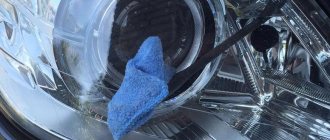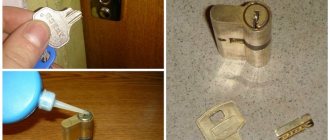It would seem that getting a speck of dust into the eye is not a big problem, and the most that can be expected in such a situation is a little discomfort. But be that as it may, even a small speck has gotten into the eye - this is actually a foreign body, the presence of which in the organ of vision can become a potential cause of infection or injury to the eye .
That's why you need to know how to remove such a foreign object from the eye yourself.
Symptoms and diagnosis of specks in the eye
The intensity and types of symptoms indicating the presence of specks in the eye directly depend on the size and type of such object, as well as on what part of the eyeball was affected.
In general, the symptoms of the presence of a foreign substance in the eye are as follows:
- when blinking – a feeling of “scratching” on the inside of the eyelid or the surface of the conjunctiva;
- development of swelling of the eyelids ;
- redness of the mucous membrane and irritation;
- trouble opening the affected eye;
- development of photophobia ;
- burning, itching, pain in the eyes;
- rapid blinking;
- decreased quality of vision;
- minor or, on the contrary, severe pain (depending on the size of the object and the severity of damage to the eyeball).
In fact, these signs serve not so much as signals to the brain about the presence of a foreign body, but are physiological indicators that the body is trying to independently remove the foreign object from the body by washing it out with tear fluid.
Note! But in some cases, the foreign body digs into the conjunctiva too deeply, and not only professional medical assistance is required, but also diagnostic measures that will allow one to assess the severity of the lesion.
taking an anamnesis is of paramount importance , during which the patient talks about how the foreign body got into the eye and what it is (at least approximately).
Also, if possible, the patient should at least approximately indicate the area of the eye in which he feels the presence of an object, which will make the search process easier for the specialist.
If the lesion is penetrating in nature, a simple visual examination is not enough, and
the ophthalmologist uses an ophthalmoscope, and in severe cases, even ultrasound.
In cases where the object is not visible due to its microscopic size, it is possible to instill a special dye into the eye , which has developing properties and will help to see the speck.
general information
A splinter is more than just a splinter of wood stuck in your finger. Particles of any material - metal, glass, plastic, if they are small in size and have a pointed end - can cause such damage. The danger of such a phenomenon is quite great, although many underestimate it. If the fragment is not removed in a timely manner, there is a risk of its penetration into deep tissues. Once it reaches the muscle fibers, it causes inflammation. In addition, an infection can enter the body along with it.
Vinikli nutrition - consult a doctor
To make an appointment for a consultation, call or fill out the return form:
(050) 301-99-26 (067) 446-11-79
Damn,
Your request has been successfully sent!
A call center specialist will contact you as soon as possible to clarify all the details.
At the same time, oddly enough, most people do not know how to remove a splinter, especially if it sits deep enough. It is almost impossible to pull out a foreign body with your fingers. Most often, only the upper part can be removed in this way.
Particularly dangerous are splinters that are completely hidden under the epidermis and are not visible on the surface of the body. They are very difficult to detect. In this case, the person feels pain and tingling in the affected area and cannot understand the reasons for their occurrence. It's even worse if the victim is a child. It is difficult for the baby to indicate exactly where it hurts, so parents cannot help him. To solve the problem, you need to consult a pediatrician.
How to remove speck from your eye yourself?
If the speck is small, does not have sharp edges and is easily visible on the surface of the conjunctiva, you can get it out even without outside help .
First of all, before trying to remove the speck yourself, you just need to wait to see if the foreign body comes out on its own , if this does not happen within 3 days.
5 minutes –
it’s worth blinking hard, but only if this action does not cause pain.
Next, you can try this method: pour clean warm water into a container into which you can immerse your face (it’s better to take a small basin).
The face must be immersed in this container , and when the affected eye is in the water, blink it several times . If the foreign object is not lodged too deeply in the tissues of the eye, it will be washed out.
If this does not give any results, you can use medium pressure to rub the closed eyelid, under which you can feel the speck . Rubbing movements must be made in the direction from the outer corner of the eye to the inner.
Need to know! If the speck is clearly visible, and you have a mirror and a clean handkerchief (or napkin) at hand, you can try to carefully remove the foreign body by folding the napkin or handkerchief into a “triangle” to form a tight, sharp corner.
LiveInternetLiveInternet
Quote from the message Blog_Don't_-_get sick
Read in full In your quotation book or community!
ALL WAYS TO REMOVE A SHARD OF GLASS BY YOURSELF.
The fragments can be of different sizes and shapes. Basically, small fragments cause more discomfort and problems, since it is difficult to pull a glass shard out of your finger. Now there are a large number of methods on how to remove a shard of glass.
• How to remove a shard of glass - instructions
1. It is not recommended to press or squeeze the area where the fragment is located, as this may deepen it further. Due to these manipulations, the fragment can split into several parts and this can significantly complicate the entire process of removing it;
2. To remove a glass shard, you need to wash the affected area with soap and wipe dry with a towel that absorbs moisture well;
3. It is worth carefully examining the damaged area under a magnifying glass in order to examine it in more detail and understand how to more conveniently get to it and remove it;
4. After this, carefully remove the fragment and clean the affected area. Apply a small layer of antibacterial ointment and cover the sore spot with an adhesive bandage until the finger is completely healed.
• Painless method to remove glass shards
Purchase ichthyol ointment at any pharmacy, which can be sold without an accompanying prescription. Apply a small amount of ointment to the damaged area and cover your finger with an adhesive bandage. Literally a day later, remove the patch and the glass shard should come to the surface on its own. How to remove a shard of glass using soda?
If your shard is small enough, you'll need to make a fairly thick paste with a teaspoon of baking soda and water. Place the resulting homogeneous mass on the affected area and bandage it well. After a day, it is necessary to remove the applied compress, clean the surface and the fragment should come to the surface on its own. After which, it can be safely removed with water or a cloth.
• How to remove a piece of glass with an adhesive bandage?
1. Place an adhesive plaster on the skin with the splinter;
2. In order for it to come out immediately, it is necessary to tear off the adhesive plaster in the opposite direction to the fragment.
How to remove a glass shard with tweezers?
1. Before removing the glass shard, it is necessary to sterilize the end of the tweezers with an alcohol solution;
2. A magnifying glass can be very helpful. Carefully examine the affected area and determine exactly how the fragment got stuck in your finger. If it enters horizontally in relation to the skin, it is best to use nail clippers or a needle;
3. If the end of the fragment sticks out at an angle, then grab it and pull it in the opposite direction as it entered under the skin.
• How to remove a piece of glass with a needle?
1. Before removing the glass shard, it is necessary to sterilize the end of the needle with an alcohol solution;
2. Find on your finger the place where the fragment is supposed to be located;
3. Insert the needle shallowly under the skin;
4. Use the end of the needle to pick out the skin under which the splinter is hidden;
5. If you see a splinter sticking out of your finger, use tweezers to remove it. If the fragment is lodged deeper in the finger, you need to use a needle to push the fragment for better removal.
• How to remove a shard of glass with nail clippers?
1. Before removing the glass shard, it is necessary to sterilize the sharp ends of the tongs with an alcohol solution;
2. Remove a little excess skin from the area where the splinter is located;
3. Carefully open the incision, and if you see a foreign body protruding, use tweezers to quickly remove it. If the end of it is firmly lodged in your finger, you will need a needle to push the fragment to come to the surface.
• How to remove a piece of glass with a potato?
1. To remove a glass shard using this method, you will need a small piece of cut potato;
2. Place a piece on the affected area with the cut facing the sore spot;
3. Hold it for 10-15 minutes, and the potato will help the fragment to come to the surface;
4. In no case should you press, as you can drive the fragment even deeper into the body.
It is worth remembering that mostly small fragments leave the body on their own within one week. Sometimes it’s easier to let the body heal itself than to pull out a shard of glass using improvised means. If the glass shard is serious, you should immediately consult a doctor to remove the shard. Do not try to get it out with your own hands.
SOURCE
First Aid Series:
Part 1 - HOW TO STOP NOSELEEDS WITH ESSENTIAL TAMPONS. Part 2 - Providing first aid to children in different situations... Part 22 - Why is it dangerous to blow on a wound Part 23 - Laryngeal edema in a child is a dangerous condition that requires emergency assistance Part 24 - ALL WAYS TO PULL OUT A GLASS SHARD BY YOURSELF
How to get a speck out of a child's eyes?
The main problem that arises when something gets into a child’s eye is to persuade him not to cry and make him sit still so that the foreign object can be easily removed.
The first step is to open the child's eye with your thumb and forefinger to see where the foreign object is. If the object is localized , it is removed using a cotton swab or a folded handkerchief.
If there is a suspicion that the speck is on the inside of the eyelid , you need to ask the child to close his eyes (but not too tightly and do not squint his eyes), then rub the surface of the eyelid from the outer to the inner corner with rubbing movements .
At the same time, you can try in the same way to “push” the speck to the edge of the eyelid and remove it from there if the foreign body reaches the eyelashes.
Splinter danger
Nature has provided a mechanism for independently combating splinters. After all, sharp foreign bodies cut into our skin quite often - in nature, when working in the garden, or when handling sharp objects carelessly. Cells of the immune system, primarily tissue phagocytes, rush towards the foreign agent, and the process of “absorption” of the uninvited guests begins. Some of the cells die, forming the basis of pus. If the splinter is small and located in the superficial areas of the skin, it is pushed to the surface along with pus. But in the case of deep penetration into the tissue, the process of suppuration becomes widespread. If you do not pull out the splinter in this case, the affected area begins to tear, and the following symptoms appear:
- Pain, sometimes severe, throbbing.
- Redness and swelling of the sore spot.
- Increased body temperature.
- Spread of inflammation to neighboring areas.
This situation leads to the development of complications, including sepsis. Therefore, the general approach is to immediately remove any splinters when they are discovered.
This is usually available at home. Difficulties arise when a child has a splinter when he cannot accurately name the location of the injury. In such cases, you need to contact a pediatrician or traumatologist.
Don't leave a splinter unattended! It may be dangerous!
Eye contact with metal and wood shavings
If relatively large metal shavings , you can try to remove them using a magnet. The smaller the object, the more likely it is that the method can help.
Be careful! On the other hand, not everyone has a strong enough magnet at hand, which would also have an elongated shape so that it can be brought as close as possible to the body of the eyeball.
Regarding wooden shavings, you should know that if such a body does not come out with tear fluid in the first five minutes, you will not be able to get it out on your own, and the intervention of a surgeon or ophthalmologist is required .
Types of foreign bodies that can damage gums
Almost every person knows what a splinter is. Small pieces (wood, metal shavings, splinters, thorns, plant thorns, etc.) from time to time dig into the skin of the hands or other parts of the body. But a foreign object inside the gum can come as a complete surprise. If it is very small, it does not immediately provoke unpleasant sensations. Soreness and swelling appear only after inflammation develops.
Often a foreign body is found in a child’s gum. This is due to the fact that any objects that fall into his hands almost immediately end up in his mouth. If you do not remove embedded shavings, splinters or splinters, gingivitis will develop or a local gingival abscess will form.
The following items can damage your gums:
- chips from a toothpick or pencil;
- natural, plastic toothbrush bristles;
- pieces of plastic (from chewing plastic objects);
- husks from nuts and seeds;
- fish bones of different sizes;
- small fragments of filling material;
- metal shavings or pieces of dental instruments broken during dental treatment;
- crumbs of chipped dentin;
- other foreign bodies embedded in the gingival tissue at the time of injury.
What to do after removing the foreign body?
Immediately after a speck or any other foreign body is removed from the eye, the patient may still experience signs of irritation and mild pain .
Important! This is normal, since regeneration processes begin in the damaged eye, accompanied by such sensations. If the symptoms are easily tolerated, you can wait until they pass (this can take two to three days on average).
But you can speed up the healing process by instilling ophthalmic drops of the “natural tear” category in the next few days . The best options are Visine and Tear, which contain virtually no active ingredients that have a therapeutic effect and only restore the protective tear film.
If such products are not at hand, you can wash your eyes daily with tea leaves (just not too strong).
Removal with glue
PVA glue is ideal for this procedure. It hardens in the form of a film, which is then easily removed. Moment glue cannot be used, as it is very difficult to remove from the skin, and the composition does not always come off in a single layer.
Before the procedure, you need to wash your hands and the affected area, and then dry it. The glue should be applied in a thick layer to the foreign body and the skin area around the wound. It should completely cover the shard. You should wait until the composition hardens completely. The glue can take quite a long time to dry - about 30-60 minutes. Then you need to remove the film and make sure that the foreign body is completely removed.
Instead of glue, you can use depilatory wax. This product is especially convenient for removing thin splinters. Wax is applied to the affected area, and a piece of tissue is attached on top. After hardening, the composition is torn off with a sharp movement. You can also use a special depilatory patch.
How to show interest: the best phrase to start a conversation with a man
To prevent children from quarreling, parents built an unusual bunk bed
Just extend your hand. Savvy shoppers take the 'far away' bottle of oil
Features of removing a splinter from a child
Children easily run towards adventures, sometimes this ends in injury and tears. When trying to provide help, they resist and are capricious. It is necessary to reassure, explain that it is not scary to pull out a splinter. Try to distract by talking about your favorite fairy tale or cartoon. After the foreign object is removed, treat the wound with iodine and blow on it together to make the pain stop faster. Special patches with designs are made for children; they are fun and colorful. The child will be happy to wear it. You can apply a gauze bandage and color its edges with felt-tip pens. A fun treatment will show children that removing a splinter is not at all scary.
Possible consequences
A splinter is a foreign body. Getting it under the skin can lead to infection. If this happens, the site of injury will swell, turn red, and begin to fester. If the chip gets deep under the nail, it will begin to tear away. In addition to pain, there is a danger of infection spreading into the blood.
Any splinter must be removed in a timely manner, and if you are unsuccessful in trying to do it yourself, do not delay contacting a specialist.
Suppuration in the finger can lead to panaritium, which can be quite problematic to cure. In severe cases, dysfunction of the ligaments that move the fingers occurs due to loss of fluid around them. The finger will remain in a fixed position; it will be impossible to bend or straighten it.
Secondary infection of the wound often leads to tissue necrosis, rejection of the nail plate or its deformation. Microbes can get in not only with a splinter, but also when trying to remove it with untreated tools or dirty hands.
Thus, any splinter must be removed from the tissues. Treat skin and tools for self-extraction. A splinter can cause complications, so do not delay seeing a doctor if the injury site begins to redden and swell.
Products for treating wounds in children
Below we list the most popular and affordable means for treating superficial wounds in children:
- Iodine. Suitable for superficial abrasions, but not for deeper injuries.
- Diamond green.
- Hydrogen peroxide. It is the drug of choice for first aid in the treatment of superficial abrasions in children. Allows you to clean abrasions and scratches well. An equally important property is stopping bleeding.
- Furacilin. To prepare a solution for topical use, dissolve the tablet in water.
- Miramistin. It is also an antiseptic for topical use. Allows you to prevent suppuration. If a purulent process occurs, it allows you to fight it. A pleasant bonus will be the possibility of using this remedy for acute respiratory viral infections, sore throats and pharyngitis in children.
- Chlorhexidine.
An antiseptic helps prevent suppuration.
To speed up healing, ointments and creams can be used such as:
- Levomekol;
- Betadine;
- Vishnevsky ointment;
- cream Bepanten plus.
Superficial bacterial skin infections
Folliculitis
- inflammation of the hair follicle: abscess around the hair, redness of the surrounding area.
Pemphigus of newborns
- a severe contagious disease when inflammatory blisters cover the baby’s entire body, forming crusts and ulcers.
Impetigo
- against the background of redness, painless blisters with cloudy contents appear. Then the blisters shrink to yellowish crusts, leaving erosions.
Impetigo often occurs in children and young women. Localization: face, under the hair of the head, limbs. When staphylococcus attaches, the crusts become greenish or bloody. The disease spreads quickly in communities. If you suspect it, you need to isolate the child and bandage the wound.
Prevention
Observe the following rules:
- After visiting the gym, wipe the areas that came into contact with the equipment with an antiseptic.
- Treat cuts and wounds with antibacterial drugs (iodine, salicylic alcohol, hydrogen peroxide) immediately after they occur.
- Do not share hygiene items or cosmetics with other people.
- Places of abscesses and impetigo should not be washed with water, combed, or pressed.
- Avoid spicy fatty foods and sweets.
Make an appointment with a dermatologist on time.
The doctor will help you identify the cause of the inflammation, do the necessary tests, and select a treatment that suits the type and stage of pyoderma. December 5, 2020
Author of the article: dermatologist Mak Vladimir Fedorovich
Features of facial skin infections
The blood supply to the organs of the head, face, and membranes of the brain is closely connected. Incorrect treatment and squeezing of pimples is dangerous due to the spread of bacteria through the blood and lymph. You can achieve an increase in the area of the affected area, such dangerous complications as meningitis, abscesses and phlegmon, and inflammation of the eyes.
Before deciding on cosmetic procedures - cleansing, peeling, mesotherapy - undergo an examination by a dermatologist to determine the cause of the pustular rash and receive treatment.
Traditional methods
If the splinter is not very big, you can use the knowledge of previous generations. These treatments are collected and tested by many people.
Their advantage is that the necessary items are always at hand and are often used in everyday life. The contents of the first aid kit in the house can be used in unusual ways.
- Press the sticky side of the adhesive plaster onto the damaged area. We remove it in the direction opposite to the entry of the splinter. You can use tape or rag tape in the same way.
- Mix clay and cottage cheese in equal proportions, apply to the wound, cover with cellophane and bandage overnight. As a substitute for the ingredients, bread mashed in your hand and a highly salted solution of water are suitable. The paste is applied to the site of entry and bandaged overnight.
- A banana peel applied to the damaged area will soften the skin in a few hours, and the chip will easily come out on its own.
- You can speed up the steaming process with warm water and salt. In 20-30 minutes, a small splinter will come out of the skin, and the mark after such a procedure will quickly heal.

